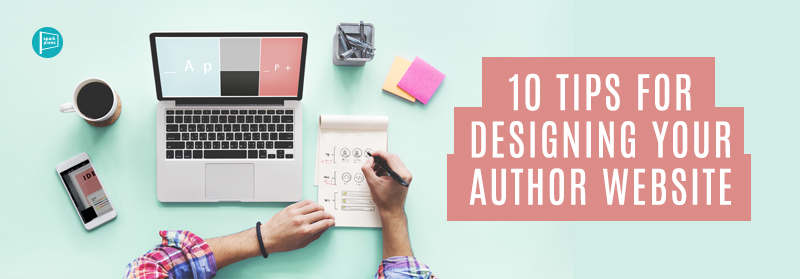
As a new author or a seasoned one, marketing your work is important. If you want to sell your book, provide a behind-the-scenes look at your writing process, interact with readers, or give away gifts, an author platform is the best place to do so. Websites act as your online home. They can become stronger with time, putting your readers directly in front of you, making your next book promotion that much easier.
The number one factor in any successful website is navigation — and designing your author website is no different. While it can be an intimidating process, here are a few tips on where to begin.
1. Select the Right Host
If the idea of designing your author website seems daunting to you, try using a host that makes the work easy for you. Some, like Squarespace, Wix, or WordPress, focus on creating content and are pretty user-friendly. Be sure to look closely at the different costs for sites as there are both paid and free options.
2. Purchase a Domain
The URL is the domain, and it’s where your site lives. This should be based on the name you publish under rather than any titles of your books. Consider a unique name that represents you more than your novels, and your name also works too. Just know, it’s okay to research around before you decide. This domain has the potential to host every work you produce. While it purchasing a domain isn’t mandatory, its pays in the long to keep your site secure and SEO friendly; your options become very limited with a free domain.
3. Create an ‘About Me’ Section
Your “About Me” section is a great place for your professional biography and author photo. Keeping this information here will limit the urge to center your website around a large headshot and you. This will also be the most frequented place visited on your site; it’s where readers will learn all they need to know about you. You’ll also want to keep this up to date with information about what you’re currently working on, or any news you want to share with the author.
4. Keep the Design Clean
Less is more in a web design. Don’t feel as if you need to fill every corner; open white spaces can be your friend. Hosts like WordPress offer themes for your website that you can add or edit any time you like. If you don’t already have a design in mind, having one that is clean and appealing to the eye will catch more readers. Websites that have too many colors or themes tend to distract your audience from the main purpose.
5. Make Buying Your Books Easy
Your books are the bread and butter of your website, so create a place where they can live. This could be in a list fashion with full or short size descriptions. Make it simple for readers to see your books or the series of books and figure out which ones they’ve read. Link to your book on several retailers; we recommend linking to IndieBound, Amazon, Barnes & Noble, Bookshop, and at least one local indie bookstore that carries your work.
6. Collect Email Addresses
This works well if you have a blog or a newsletter. If you do not have either yet, that is okay. Collecting email addresses can keep you one step ahead, so when it comes time to remind readers of your next book, or your newly designed newsletter, you’ll have a list handy. Adding a fill in popup form either on your home page or in your about me section are great places to store this.
7. Place Social Media Icons in Sight
Social media is a great way to market your book and connect with readers. Many sites make the mistake of placing the icons at the very bottom of the page, but very few people make it to the bottom of a webpage. Place your icons at the top of your page in a section that is noticeable and responsive for readers to head directly to your pages.
8. Manage Your Own Creation or Hire Someone You Trust
The majority of website building systems make it easy to update your site. Once a new idea or new way of communicating comes to you, try updating it yourself. This keeps your content relevant without delay. Improving your site happens over time, so having someone you trust when designing your author website to make those adjustments you can’t will also save you time.
9. Add Your Contact Information
Until you reach A-list celebrity status, make it easy for the media to contact you. Playing hard to get with your contact information will only steer potential reviewers or interested media in the opposite direction. A contact form or an email address that is geared specifically for contact inquiries is a simple solution. You can also encourage readers to connect with you on whichever social media platforms you are on.
10. Include a Press Page
This is where you’ll want to host your best blurbs or reviews, and any media coverage on you or your book. Collect any praise that appeared within your book and add them to this section. It lets readers and the press know who has read your work and who they can trust if they follow those recommendations.

Leave A Comment